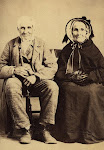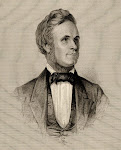by Jane S. Porter
William and Rachel had saved for this trip for a long time and were among the few who paid their own passage, but they barely managed to obtain steerage status, a section of the helm occupied by passengers paying the lowest fare. The ship’s log listed his occupation as “engineer.” Most Church member coming to America on ships charted by the LDS Church borrowed the money from the Perpetual Emigration Fund. Quite likely William and Rachel also paid for their own train ride. Actually that was something of an accident.
An ocean voyage in 1867 was known to take five or six weeks-long enough when one is rocking and rolling on the Atlantic swells. A group of saints agreed to meet each of the immigrant ships as it came into harbor, bring the saints to the train, and accompany them to the outfitting station where they would be loaned or sold a wagon and team for the overland journey. As luck would have it, the Hudson was caught in a terrific storm in mid-ocean, and threatened to capsize. Not only were the passengers and crew battered and bewildered for the two week storm, but when they finally limped into port there was no Welcome Committee. Apparently the committee had given up hope for their survival and had left without them. When they arrived in New York on July 19 they had no choice but to find lodging and decide what to do. No doubt stories had circulated about the ill-timed August departure of the Martin and Willie Handcart Companies ten years earlier, and the saints didn’t want to wait in New York and then become trapped in mountain snow later.
The beleaguered traveler found a place to rent, found jobs, and worked in New York until the spring of 1868. As their first contribution to the building of America, William and his sons worked in the masonry trade making bricks and in the building trade in New York. Such a city was overwhelming for most immigrants; but for the Stiffs who had lived near Basingstoke, it was just another place to work. And they did quite well. James had met Alice Watson on board the ship and married her the day before their names were added to the “arrivals”. So anxious to finalize the marriage he had the ceremony performed before they got of ship. Hence, his marriage date is July 18 and their arrival day is July 19.
The next spring they bought train tickets as far as the train track had been laid, and climbed aboard with the little they owned. For Rachel who was 59 and William who was 63, it must have been a journey filled with questions. How would they continue their journey when the train left them in the middle of the great American Plains, as far as there were tracks by then? There wasn’t even a road from the railroad tracks to anywhere else yet. They didn’t even know if there would be an outfitting station with friendly hands to help them. They had worked so hard all their lives, could they really walk 500 miles or more through mountain with no wagon? Would they live long enough to pay back the P.E.C.? Yet these were energetic, creative people who had long since learned that they could make things work to their advantage. They had taught their children well to build and work and trust the Lord, and they were not intimidated by difficulties. They seem not to have complained. Rather they worked through this obstacle as they had all others in their lives; knowing that with hard work and an positive attitude they could do anything.
The Railroad
On July 1, 1862 President Lincoln had signed a paper authorizing the construction of the railroad to California. The Union Pacific Railroad was to begin building track westward from Omaha, Nebraska and the Central Pacific would build eastward from California. Land was granted and subsidies were in place. Although work began in 1863, little track was laid. For the next three years, disputes over government subsidies halted progress until finally in 1866 work began again. By July of 1868 the Union Pacific had far outpaced its western counterparts and had steamed its way into Eastern Wyoming. Just a few days before the Neville-Stiffs arrived in New York, General Grenville M. Dodge, Chief Engineer of the Union Pacific Railroad drove a stake into the ground on July 4, 1867, as a result of his survey of land for the railroad bed. The stake stood alone in the wind swept Wyoming Plains at the foot of the Laramie Range of Mountains. There wasn’t a dwelling or a fence for 50 miles in any direction.
“I’m calling this place Cheyenne,” he said, “because the Cheyenne Indians are the greatest tribe in this country.” Perhaps he also said, “and I hope none of them are around.” But if he didn’t say it, he thought it because the very next day he established Fort D.A. Russell a bit northwest of his first stake. The railroad crew was 150 miles to the east, laying track as fast as they could go, and Fort Russell assured their safety when they arrived.
Moving ahead of the tracks, a large group of settlers began immediately to move in and cash in the ready market soon to arrive. General Dodge’s U.P. crew immediately surveyed the town site, and buildings began to spring up almost overnight. By the time the train came into town on November 13, they were welcomed by numerous stores, dozens of saloons and six variety shows, complete with dancers of disrepute. By the summer of 1868 when the Stiffs arrived, the town….”…..swarmed with free land seekers, gamblers, cutthroats, speculators, outlaws, swindlers, robbers, dance hall ’queens’ and professional gun slingers. Deaths by violent means were numerous…crime and murder prevailed on the streets…armed men had become a common sight on the streets, despite a town council ordinance proclaiming an “empty holsters” law.”
The train trip was very different from the one at their home in Rotherwick to London they year before. These American emigrant trains were really freight trains, hot, stuffy, and without amenities of any kind. Generally the young men rode on top of the cars to escape the heat and humanity inside. The frequent stops were for necessities such as food and restrooms. Such a ride no doubt excited young Joseph, but had more of a sobering effect on his parent.
Climbing ever higher in altitude, the train puffed out of Cheyenne and on 50 miles wet to Laramie, the end of the line, the difficult 500 miles of the Mormon Trail still ahead. Rachel stepped down from the train slowly as she surveyed the frontier town. Laramie wasn’t a great deal different from Cheyenne, but at least the Church had established an outfitting station and welcomed the weary travelers to a place of rest. It gave them a chance to become accustomed to the mountain altitude. Laramie is 7,165 feet above sea level, and it no doubt took a while for Rachel and William to regain their normal energy.
This was no doubt an intimidating introduction to the American West, which already had a bad reputation in England. But Joseph was by then 16 years old. The stories which had come to him were exciting. That memorable day he arrived in Laramie must have fulfilled all his youthful dreams, right down to the gunslingers on the streets. In later years his children reported his love for cowboys and cattle although his talents took him into building and engineering. They remembered as a much older man he would still pray, “Father in Heaven, bless the cattle on the thousand hills.” He never lost his love for the Old West not his desire to build it up.
The Handcart
After a few days in town, they heard a lot of things they didn’t want to hear. But they also heard there was a wagon train being organized by Captain William S. Seeley which would soon be leaving for Salt Lake City. William went to work. There was little time to waste. Resources were limited, and at that late date the few horses and cattle there were, were not for sale. Likely William checked around for a few days and just gave up finding either animals or a wagon. He may have worried over it for a while, but in the end constructed his own handcart with whatever he could find in town. Then he gathered up his family and told them to get ready.
James had a wife now and would have the most questions; “Get ready? Get ready with what?”
“We have one day to join the wagon train, I have been working on a handcart and will need help to finish it.” William was never one to stand around wondering what to do next.
“And how do we get there?” Joseph was 16 and had more energy than both his parents combined, but he had an affinity for machinery and no doubt hoped for something better than his own test to get him there.
“We walk,” said William. “We haven’t much choice. We’d better start right how or we won’t make it. And I for one don’t wish to spend the winter in the wind swept, lonely, forsaken place.”
“Nor I.” Rachel had spent as long in Laramie as she wished. She was never one to stand still very long anyway. “I say we finish the handcart and leave tomorrow. I’ll get water and food together for the trip.”
“And just what will we be eating?” Joseph was always hungry.
“We’ll have the same flour and corn meal as the rest of the Saints.” said William. I have heard that supplies are sent from Salt Lake City and the ox trains reach the Green River. After that we’ll be all right.”
The handcart was 40” x 29 ½” x 6” with a wheel 40” in diameter. Since the axle had an iron reinforcement and the wheels had metal strips attached to the rim, it seems unlikely that William built it without careful thought and planning. Even without adequate resources he managed to demonstrate his genius for building.
Perhaps its very durability is the reason it still exists. William made it to last, and last it did. It is the best example of a real pioneer handcart still in existence. William Neville-Stiff hadn’t made a lot of wealth or friends in his hometown of Rotherwick. He had scratched out al living from the old traditions and establishments of England, and hadn’t made money even to get himself out of the country. But he had learned to work and to build. He had taught his sons to think and to plan and to make the best from what is available. And he made a handcart which will last to the Millennium.
For two months Rachel, William and Joseph and James and his new wife Alice took turns pushing and pulling the handcart over rocks and sand and sagebrush, up over the Continental Divide, across the Green River, through Echo Canyon to the Great Salt Lake. They arrived on August 29, 1868, said goodbye to their new found pioneer friends, and continued pushing that handcart another 20 miles to Centerville where their daughter Annie lived and their house was waiting. By the 1870 census, they were living next door to John and Annie Cox, and that handcart was parked behind the house.
It is now housed in the LDS Church History Museum in Salt Lake City, Utah









No comments:
Post a Comment